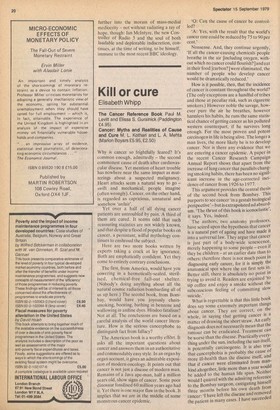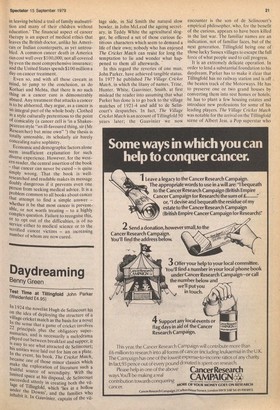Kill or cure
Elisabeth Whipp
The Cancer Reference Book Paul M. Levitt and Elissa S. Guralnick (Paddington £4.95) Cancer: Myths and Realities of Cause and Cure M. L. Kothari and L. A. Mehta (Marion Boyars £5.95, £2.50) Why is cancer so frightfully feared? It's common enough, admittedly 7 the second commonest cause of death after cardiovascular disease. Yet mention of heart trouble has nowhere near the same impact as mutterings about a suspected malignancy. Heart attacks seem a natural way to go — swift and mechanical, people imagine (often wrongly). Cancer, on the other hand, is regarded as capricious, unnatural and somehow 'unfair'.
Yet over a half of all dying cancer patients are untroubled by pain. A third of them are cured. It seems odd that such reassuring statistics are not widely known, and that despite a flood of popular books on cancer, a persistent, wilful mythology continues to enshroud the subject.
Here are two more books written by experts taking a crack at lay ignorance. Both are emphatically confident. Yet they come to entirely contrary conclusions.
The first, from America, would have you cowering in a hermetically-sealed, sterilised, chemical-free fall-out shelter. (Nobody's doing anything about all the natural cosmic radiation bombarding all of us up here.) The second book, from BomL bay, would have you joyously chainsmoking, boozing, bathing in benzene and wallowing in aniline dyes. Hindoo fatalism? Not at all. The conclusions arc based on a careful analysis of the world cancer literature. How is the serious cancerphobe to distinguish fact from fallacy?
The American book is a worthy effOrt. It asks all the important questions about cancer and answers them in an authoritative and commendably easy style. In an organ by organ account, it gives an admirable exposition of modern oncology. It points out that cancer is not just a disease of modern man. Remains of a Java ape-man, half a million years old, show signs of cancer. Some poor dinosaur fossilised 60 million years ago had it. Yet there is one major flaw in the book. It implies that we are in the middle of some monstrous cancer epidemic. `C): Can the cause of cancer be controlled?
'A: Yes, with the result that the world's cancer rate could be reduced by 75 to 90 per cent.'
Nonsense. And, they continue urgently, 'If all the cancer-causing chemicals people breathe in the air [including oxygen, without which no cancer could flourish?) and eat in their food [carbon?] were eliminated, the number of people who develop cancer would be dramatically reduced.'
How is it possible, then, that the incidence of cancer is constant throughout the world?
(The only exceptions are a handful of tribes and those at peculiar risk, such as cigarette smokers.) However noble the savage, how ever pure the air he breathes, however harmless his habits, he runs the same statistical chance of getting cancer as his polluted western counterpart, if he survives long enough. For the most proven and potent carcinogen in life is being alive. The longer a man lives, the more likely he is to develop cancer. Nor is there any evidence that we are entering a cancer epidemic. A paper in the recent Cancer Research Campaign Annual Report shows that apart from the increase of lung cancer that parallels chang ing smoking habits, there has been no significant increase in the age-corrected incidence of cancer from 1926 to 1977.
This argument provides the central thesis of the second book from Bombay. This purports to see cancer 'in a gestalt biological perspective' —but is extrapolated ad absurd urn. 'The thrust of this book is iconoclastic', it says. Yes, indeed. The authors, two anatomy professors, have seized upon the hypothesis that cancer is a natural part of ageing and have made it into a universal law. They argue that cancer is just part of a body-wide senescence, merely happening to some people — even if they be children — at an earlier date than to others: therefore there is not much point in diagnosing early cancer, for it is simply the anatomical spot where the rot first sets in. Better still, there is absolutely no point in trying to avoid it. Readers are enjoined 'to sip coffee and enjoy a smoke without the subconscious feeling of committing slow suicide.' What is regrettable is that this little book does say some extremely important things about cancer. They are correct, on the whole, in saying that getting cancer is a matter of drawing the short straw. An early diagnosis does not necessarily mean that the tumour can be eradicated. Treatment can be worse than the disease. Practically everything under the sun, including the sun itself, is potentially carcinogenic. It is also true that cancerphobia is probably the cause of more ill-health than the disease itself, and that if cancer were eliminated from mankind altogether, little more than a year would be added to the human life span. Neither would I quarrel with the admiring reference to the Bombay surgeon, castigating himself, three months before his own death from cancer: 'I have left the disease and removed the patient in many cases. I have succeeded in leaving behind a trail of family malnutrition and many of their children without education.' The financial aspect of cancer therapy is an aspect of medical ethics that leaves the British doctor, unlike his American or Indian counterparts, as yet untroubled. A common cancer death in America can cost well over $100,000, not all covered by even the most comprehensive insurance; and the United States spends $100 million a day on cancer treatment.
Even so, and with all these caveats in mind, to jump to the conclusion, as do Kothari and Mehta, that there is no such thing as a cancer cure is demonstrably absurd. Any treatment that attacks a cancer is to be abhorred, they argue, as a cancer is an integral part of the whole body. Clothed in a style culturally pretentious to the point of comicality (a cancer cell is 'in a Shakespearean style "an ill-favoured thing, sir (Mr Researcher) but mine own" ') the thesis is totally untenable, its scholarly air barely concealing naive sophistry. Economic and demographic factors alone seem insufficient explanation for such diverse experience, However, for the western reader, the central assertion of the book — that cancer can never be cured — is quite simply wrong. That the book is wellresearched and readable makes its message doubly dangerous if it prevents even one Person from seeking medical advice. It is a problem common to all books about cancer that attempt to find a simple answer — Whether it be that most cancer is preventable, or not worth treating — to a highly complex question. Failure to recognise this, or to opt out of the difficulties, is of no service either to medical science or to the terrified cancer victims — an increasing number of whom are now cured.



































 Previous page
Previous page